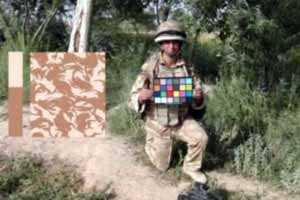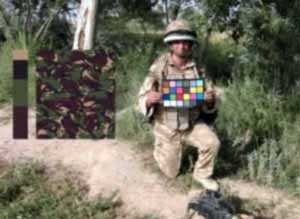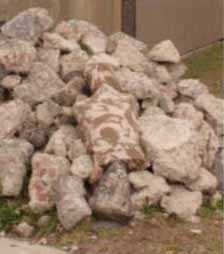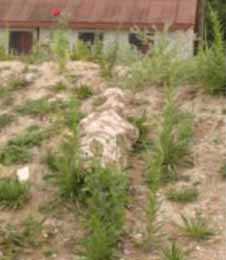Articles >>
Testing The New Multi-Terrain Camouflage
Category: Future Technologies

The Defence Science and Technology Laboratory (Dstl), the Ministry of Defence civilian scientists, working with the MOD Defence Clothing Project Team, has tested and trialled new multi-terrain camouflage clothing that has been proven to improve mission effectiveness across a range of different backgrounds. It is the first time in 40 years the Armed Forces have changed the camouflage pattern. George Philpott, Land Battlespace Systems, Dstl, says: “Dstl scientists researched and tested whether a mixed multi-terrain camouflage pattern would improve mission success and basically keep soldiers hidden for longer during ambush operations or when on patrol. It is not just a question of colours; we looked at texture and tone of patterns, how the light reflects and how well it disguises the wearer when observed both close up and at a distance. “Dstl‟s work is all about creating battle-winning technology for UK armed forces on current operations, and we're proud we were able to cram all the work in to just six months, with extra people working a lot of extra hours to get this research and testing complete.” Troops in Helmand, Afghanistan, operate in a mixed landscape: desert, woodland, mountainous, urban etc. Dstl assessed whether a multi-terrain camouflage was better than the standard army woodland camouflage disruptive pattern material (DPM) or the desert DPM and if so what is the best pattern, or balance of colours. The two current camouflage schemes were tested alongside an existing off-the-shelf multi-terrain camouflage to see which performed best across various backgrounds that soldiers are likely to encounter across the landscape in Afghanistan. Computer modelling was carried out across representations of the green zone, desert and transition backgrounds. Soldiers operated in various scenarios in a simulated set of environments to test how the different camouflages performed in situations where staying undetected was important. Overall the multi-terrain performed best, supporting the theory that a multi-terrain camouflage offers improvements when soldiers move between different places and backgrounds. Dstl also conducted interviews and subjective testing with service men and women to understand and evaluate whether they would actually be happy to wear the new camouflage and whether the concept of a multi-terrain camouflage was desirable and effective. |

As a result of this work, it was determined that a multi-terrain camouflage could improve mission success so Dstl set about testing available multi-terrain patterns and creating new ones for testing. Christopher Jones, Air & Weapons Systems, Dstl, adds: “In addition to existing aerial photography, Dstl sent cameras to Helmand for soldiers to take specific scientific photographs of the various backgrounds and landscapes they operate in.” Dstl teams in the UK, at Fort Halstead, near Sevenoaks in Kent and at Portsdown West, near Portsmouth in Hampshire, measured the colour properties for each image and identified seven major background types. These colours were then used for Dstl's camouflage optimisation and testing programme. Christopher Jones continues: “The colours and backgrounds in Helmand are similar to those found in parts of the UK, so we used the colour data from Afghanistan and used it to identify places where there was a good colour match, to allow us to run large scientific trials.” The Afghanistan background colours were used to generate new multi-terrain type camouflage based partly on the shapes and patterns of the existing UK woodland DPM. These were tested against the current army woodland and desert uniforms, to act as a baseline, and a commercially available pattern from Crye Precision. Ten camouflage suits were trialled in five tests to assess overall performance with pilot trials held before the final main testing. The trial team developed experimental techniques, which were initially established through collaborative research with other NATO countries. Lt Col Toby Evans, military advisor, Dstl, adds: “The detailed tests and trials looked at everything from how easy is it to spot these camouflages in different terrains and backgrounds to simply asking the soldiers who helped on the trial „which one do you like best and would feel happy wearing?” |

The tests
Observer assessment – a live trial with military personnel asked to judge the performance of each suit at 50m, 100m and 150m. The trial was carried out at Stanford Training Area, Norfolk and at RAF Donna Nook, Lincolnshire as they contained areas with similar colours and backgrounds to Helmand. Additional testing was also carried out at night to test low light performance. Statistical assessment – using a computer model of how camouflaged objects are detected, each suit was tested for its match to the seven identified different backgrounds. The following three trials took place at Catterick Garrison and included a large number of army personnel: Order rank – soldiers ranked how well close-up images of the suits performed against the seven backgrounds. Time to detect – Dstl measured the time it took soldiers to detect the 10 different camouflage patterns in the seven backgrounds using a computer-based assessment. Personal preference – soldiers were asked which their favourite three patterns were based purely on appearance and any patterns they wouldn't like to wear. |

The results
The results showed the Crye Precision Multicam performed the best, on average, across all the trials. The final camouflage has a pattern that is similar to the current woodland DPM as it allows for easy identification between soldiers and this type of pattern consistency proved popular during the research. Dstl is currently looking at future research into army camouflage clothing, optimising the camouflage to perform well in a variety of landscapes and backgrounds around the world to support wider operations. If this is successful the outcome could become the standard camouflage for all UK armed forces. |
Dstl |
HORIBA MIRA to Continue to Develop Cutting Edge Unmanned Ground Vehicle Technologies
30.07.2018
SAAB Receives Order From KMW For Mobile Camouflage Systems
19.12.2017
Rheinmetall modernizing 25 more Marder IFVs for Jordan
15.12.2017
Defence Secretary announces £55m contract for UK bomb disposal robots at DSEI
14.09.2017
Defence Science and Technology Laboratory (DSTL)
Discuss
